2017 PEUGEOT 4008 fuel consumption
[x] Cancel search: fuel consumptionPage 44 of 368
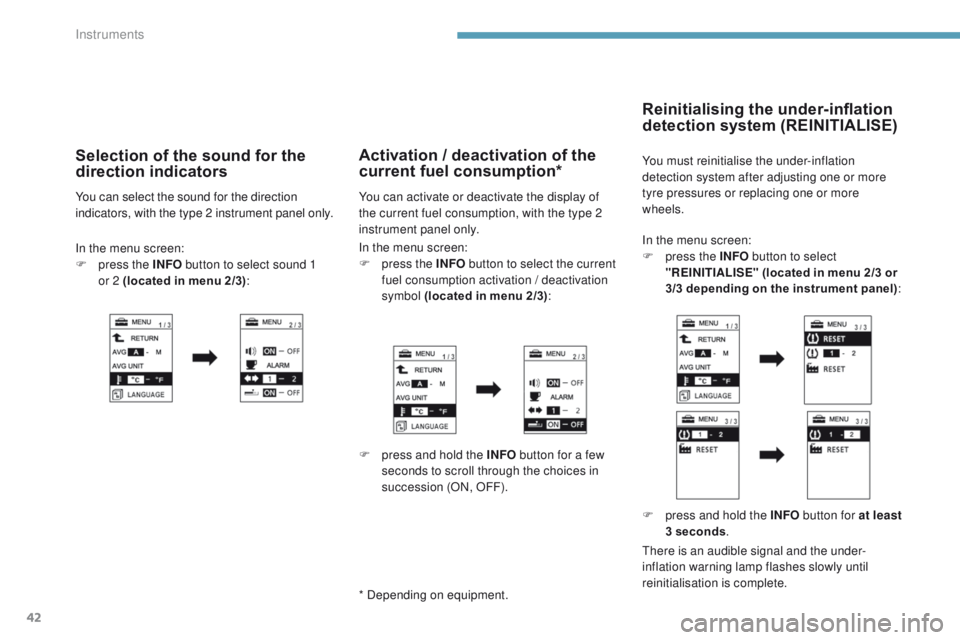
42
In the menu screen:
F p ress the INFO button to select
"REINITIALISE" (located in menu 2/3 or
3/3 depending on the instrument panel) :
Reinitialising the under-inflation
detection system (REINITIALISE)
You must reinitialise the under-inflation
detection system after adjusting one or more
tyre pressures or replacing one or more
wheels.
F
p
ress and hold the INFO button for at least
3 seconds .
ther
e is an audible signal and the under-
inflation warning lamp flashes slowly until
reinitialisation is complete.
In the menu screen:
F
p
ress the INFO button to select the current
fuel consumption activation / deactivation
symbol (located in menu 2/3) :Activation / deactivation of the
current fuel consumption*
You can activate or deactivate the display of
the current fuel consumption, with the type 2
instrument panel only.
F
p
ress and hold the INFO button for a few
seconds to scroll through the choices in
succession (ON, OFF).
* Depending on equipment.
In the menu screen:
F p ress the INFO button to select sound 1
or
2 (located in menu 2/3) :
Selection of the sound for the
direction indicators
You can select the sound for the direction
indicators, with the type 2 instrument panel only.
Instruments
Page 90 of 368
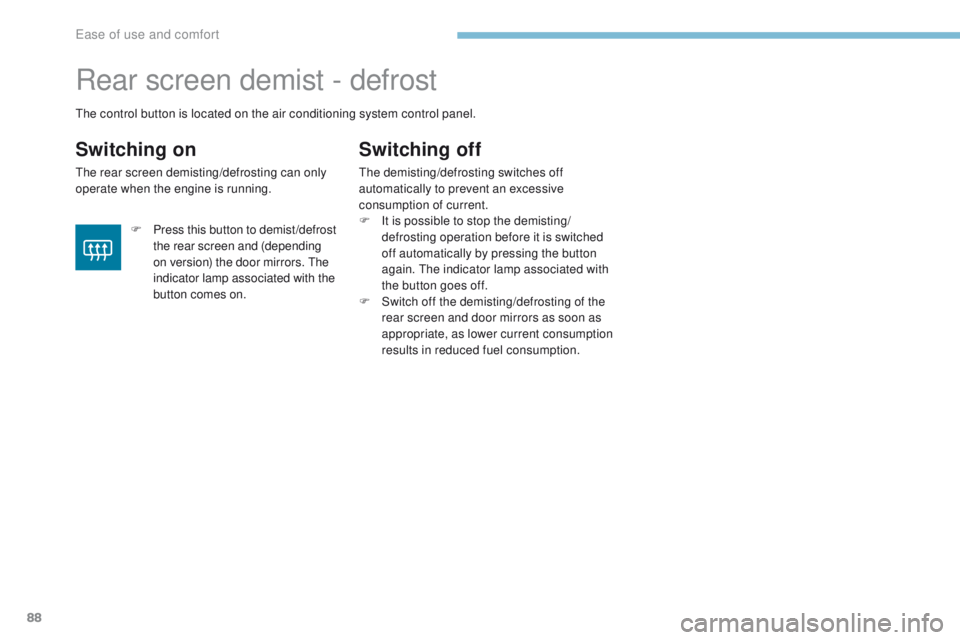
88
4008_en_Chap03_Ergonomie-et-confort_ed01-2016
Rear screen demist - defrost
Switching on
the rear screen demisting/defrosting can only
operate when the engine is running.
Switching off
the demisting/defrosting switches off
automatically to prevent an excessive
consumption of current.
F
I
t is possible to stop the demisting/
defrosting operation before it is switched
off automatically by pressing the button
again.
t
h
e indicator lamp associated with
the button goes off.
F
S
witch off the demisting/defrosting of the
rear screen and door mirrors as soon as
appropriate, as lower current consumption
results in reduced fuel consumption.
th
e control button is located on the air conditioning system control panel.
F
P
ress this button to demist /defrost
the rear screen and (depending
on version) the door mirrors.
t
h
e
indicator lamp associated with the
button comes on.
ease of use and comfort
Page 106 of 368
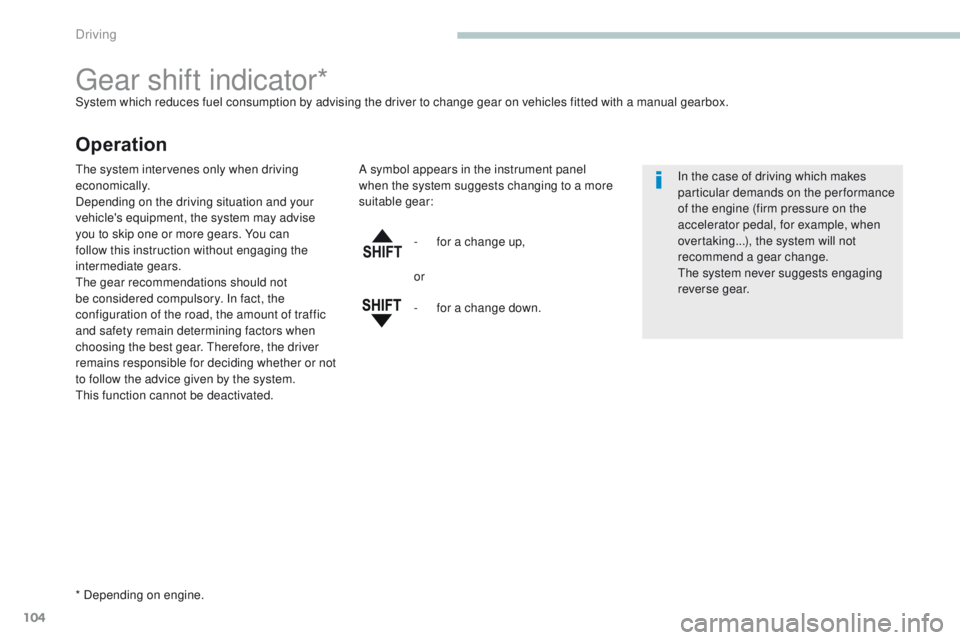
104
4008_en_Chap04_conduite_ed01-2016
gear shift indicator*System which reduces fuel consumption by advising the driver to change gear on vehicles fitted with a manual gearbox.
Operation
* Depending on engine.-
f
or a change up,
In the case of driving which makes
particular demands on the performance
of the engine (firm pressure on the
accelerator pedal, for example, when
overtaking...), the system will not
recommend a gear change.
the
system never suggests engaging
reverse gear.
the
system intervenes only when driving
economically.
Depending on the driving situation and your
vehicle's equipment, the system may advise
you to skip one or more gears. You can
follow this instruction without engaging the
intermediate gears.
th
e gear recommendations should not
be considered compulsory. In fact, the
configuration of the road, the amount of traffic
and safety remain determining factors when
choosing the best gear. t
her
efore, the driver
remains responsible for deciding whether or not
to follow the advice given by the system.
th
is function cannot be deactivated. A symbol appears in the instrument panel
when the system suggests changing to a more
suitable gear:
or
-
f
or a change down.
Driving
Page 113 of 368
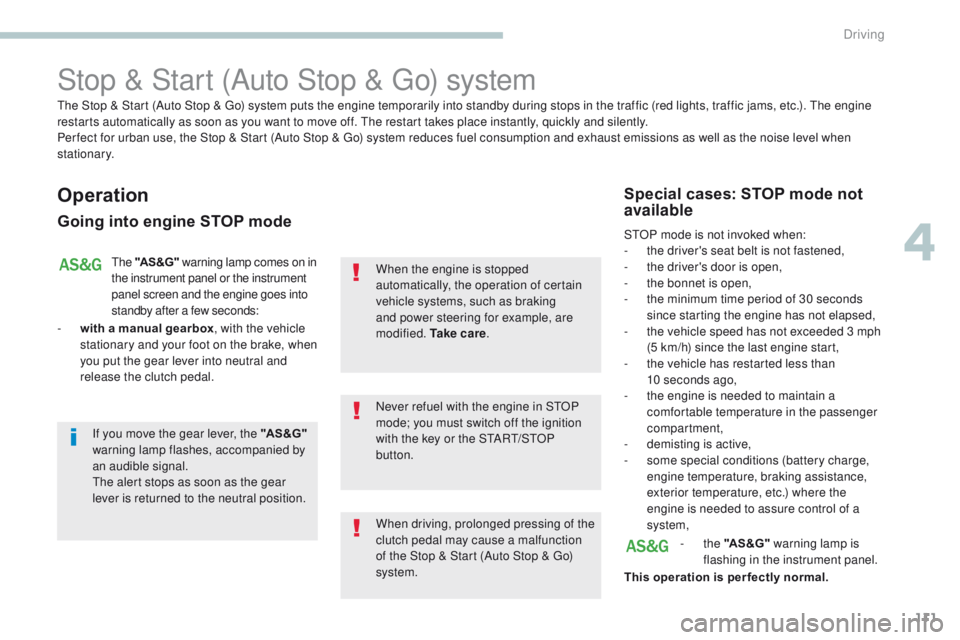
111
4008_en_Chap04_conduite_ed01-2016
Stop & Start (Auto Stop & go) system
Operation
Going into engine STOP mode
the "AS &G" warning lamp comes on in
the instrument panel or the instrument
panel screen and the engine goes into
standby after a few seconds:
-
w
ith a manual gearbox , with the vehicle
stationary and your foot on the brake, when
you put the gear lever into neutral and
release the clutch pedal.
Never refuel with the engine in S
tO
P
mode; you must switch off the ignition
with the key or the S
tA
R
t/
S
tO
P
button. When the engine is stopped
automatically, the operation of certain
vehicle systems, such as braking
and power steering for example, are
modified. Ta k e c a r e .
Special cases: STOP mode not
available
StOP mode is not invoked when:
-
t he driver's seat belt is not fastened,
-
t
he driver's door is open,
-
t
he bonnet is open,
-
t
he minimum time period of 30 seconds
since starting the engine has not elapsed,
-
t
he vehicle speed has not exceeded 3 mph
(5 km/h) since the last engine start,
-
t
he vehicle has restarted less than
10
seconds ago,
-
t
he engine is needed to maintain a
comfortable temperature in the passenger
compartment,
-
d
emisting is active,
-
s
ome special conditions (battery charge,
engine temperature, braking assistance,
exterior temperature, etc.) where the
engine is needed to assure control of a
system,
-
the "AS &G" warning lamp is
flashing in the instrument panel.
This operation is per fectly normal.
th
e Stop & Start (Auto Stop &
g
o
) system puts the engine temporarily into standby during stops in the traffic (red lights, traffic jams, etc.). t
h
e engine
restarts automatically as soon as you want to move off.
t
h
e restart takes place instantly, quickly and silently.
Per fect for urban use, the Stop & Start (Auto Stop &
g
o
) system reduces fuel consumption and exhaust emissions as well as the noise level when
stationary.
If you move the gear lever, the "AS &G"
warning lamp flashes, accompanied by
an audible signal.
th
e alert stops as soon as the gear
lever is returned to the neutral position.
When driving, prolonged pressing of the
clutch pedal may cause a malfunction
of the Stop & Start (Auto Stop &
g
o
)
system.
4
Driving
Page 116 of 368
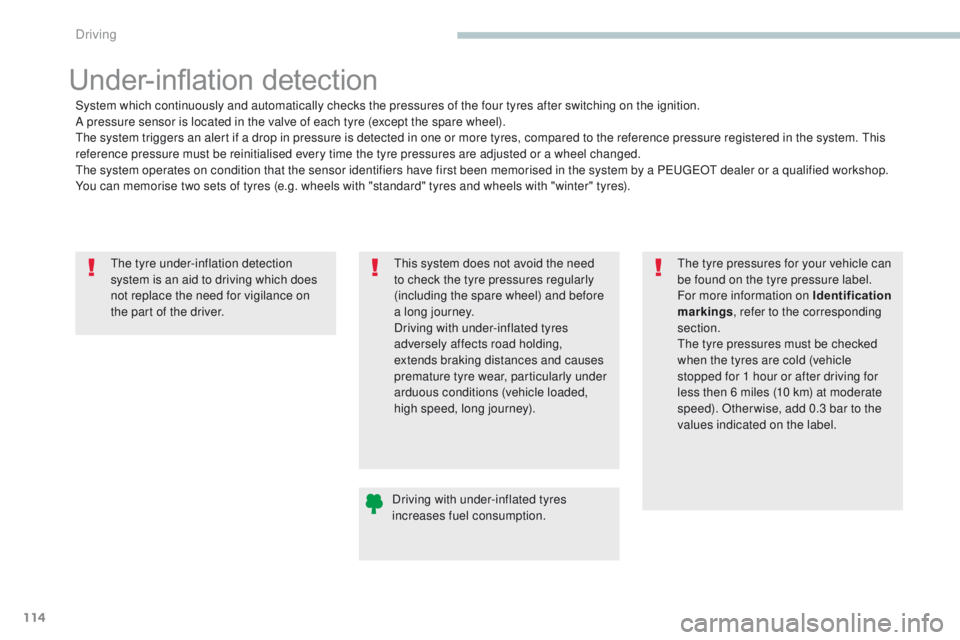
114
4008_en_Chap04_conduite_ed01-2016
the tyre under-inflation detection
system is an aid to driving which does
not replace the need for vigilance on
the part of the driver.
Under-inflation detection
System which continuously and automatically checks the pressures of the four tyres after switching on the ignition.
A pressure sensor is located in the valve of each tyre (except the spare wheel).
th
e system triggers an alert if a drop in pressure is detected in one or more tyres, compared to the reference pressure registered in the system. t
h
is
reference pressure must be reinitialised every time the tyre pressures are adjusted or a wheel changed.
th
e system operates on condition that the sensor identifiers have first been memorised in the system by a P
e
uge
Ot
dealer or a qualified workshop.
You can memorise two sets of tyres (e.g. wheels with "standard" tyres and wheels with "winter" tyres).
Driving with under-inflated tyres
increases fuel consumption.
th
is system does not avoid the need
to check the tyre pressures regularly
(including the spare wheel) and before
a long journey.
Driving with under-inflated tyres
adversely affects road holding,
extends braking distances and causes
premature tyre wear, particularly under
arduous conditions (vehicle loaded,
high speed, long journey).
th
e tyre pressures for your vehicle can
be found on the tyre pressure label.
For more information on Identification
markings , refer to the corresponding
section.
th
e tyre pressures must be checked
when the tyres are cold (vehicle
stopped for 1 hour or after driving for
less then 6 miles (10 km) at moderate
speed). Other wise, add 0.3 bar to the
values indicated on the label.
Driving
Page 235 of 368

233
4008_en_Chap09_caracteristiques-techniques_ed01-2016
Identification markingsVarious visible markings for the identification and tracing of your vehicle.
A.
M
anufacturer's plate.
I
t is riveted to the right-hand centre pillar
and carries the following information:
-
manufacturer,
-
eu type approval number,
-
v
ehicle identification number (VIN),
-
g
ross vehicle weight,
-
g
ross train weight,
-
m
aximum front axle weight,
-
m
aximum rear axle weight.
th
e tyre pressures must be checked
when the tyres are "cold", at least once
a month (vehicle having been stationary
for 1 hour or after a journey of less than
6 miles (10 km) at moderate speed).
If the tyre pressures are too low, this
increases fuel consumption.
B.
T
yre label.
t
h
is label is affixed to the driver's side
centre pillar and carries the following
information:
-
t
yre sizes,
-
t
yre pressures.C.
V
ehicle Identification Number (VIN)
under the bonnet.
t
h
is number is engraved on the bodywork
near the damper support.
th
e original tyres fitted to the vehicle
may have a load index or speed rating
higher than those given on the label;
this has no effect on the inflation
pressures.
9
technical data
Page 340 of 368
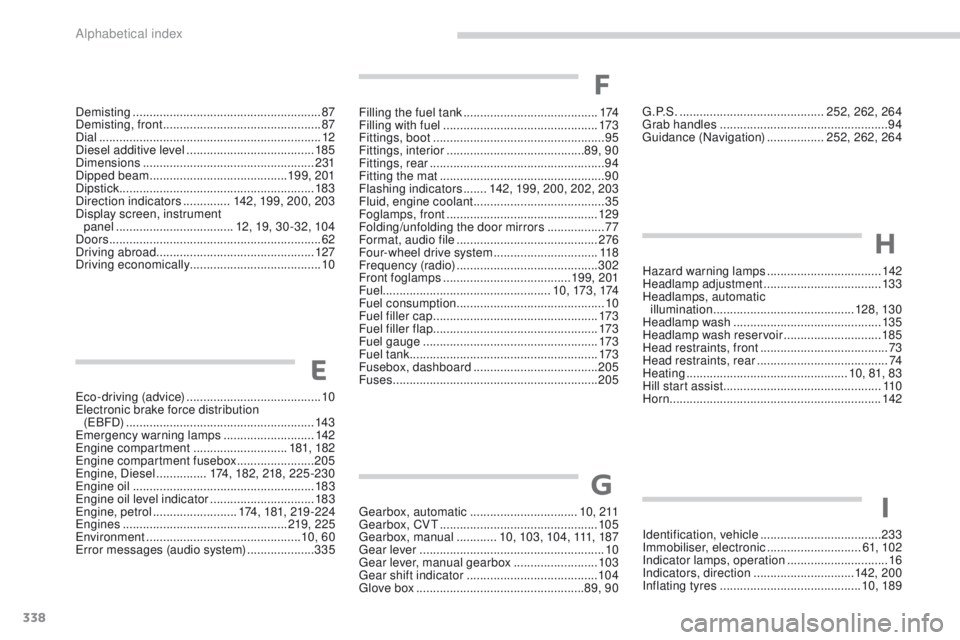
338
4008_en_Chap11_index-alpha_ed01-2016
eco-driving (advice) ........................................ 10el
ectronic brake force distribution
(
eB
FD)
........................................................ 143
em
ergency warning lamps
........................... 14
2
en
gine compartment
............................181, 182
en
gine compartment fusebox
.......................205
en
gine, Diesel
............... 1
74, 182, 218, 225 -230
en
gine oil
...................................................... 183
en
gine oil level indicator ...............................183
en
gine, petrol
......................... 174, 181, 219 -224
en
gines
................................................. 219, 225
en
vironment
...............................
...............10, 60
er
ror messages (audio system)
....................335Filling the fuel tank
........................................
1
74
Filling with fuel ..............................................
173
Fittings, boot
................................................... 95
F
ittings, interior
.........................................89, 90
Fittings, rear
...............................
.....................
94
Fitting the mat
.................................................
90
Flashing indicators
.......
142, 199, 200, 202, 203
Fluid, engine coolant
....................................... 35
F
oglamps, front
.............................................
129
Folding/unfolding the door mirrors
.................
77
Format, audio file ..........................................
276
Four-wheel drive system
...............................
118
Frequency (radio)
..........................................
302
Front foglamps
......................................
19 9, 201
Fuel .................................................. 10, 173 , 174
Fuel consumption
............................................ 10
F
uel filler cap .................................................
173
Fuel filler flap .................................................
173
Fuel gauge
....................................................
173
Fuel tank ........................................................ 173
Fusebox, dashboard
.....................................
205
Fuses
.............................................................
205Hazard warning lamps
..................................
142
Headlamp adjustment
...................................
13 3
Headlamps, automatic illumination
..........................................
128, 13 0
Headlamp wash
............................................
13 5
Headlamp wash reservoir
.............................
185
Head restraints, front ......................................
73
Head restraints, rear .......................................
74
Heating
................................................
10, 81, 83
Hill start assist ...............................................
11 0
Horn ............................................................... 142
Identification, vehicle
.................................... 23
3
Immobiliser, electronic
............................61, 102
Indicator lamps, operation
..............................16
Indicators, direction
..............................142, 20 0
Inflating tyres
..........................................10, 189
E
G
I
H
gearbox, automatic ................................1 0 , 2 11ge
arbox, CVt
............................................... 105
ge
arbox, manual
............10, 103, 104, 111, 187
gea
r lever
..............................
.........................10
ge
ar lever, manual gearbox
.........................103
ge
ar shift indicator
....................................... 104
gl
ove box .................................................. 89, 90
Demisting
...............................
.........................
87
Demisting, front
...............................................
87
Dial
..................................................................
12
Diesel additive level
......................................
185
Dimensions
...................................................
231
Dipped beam
...............................
..........
19 9, 201
Dipstick
................
..........................................
183
Direction indicators
..............
142, 199, 200, 203
Display screen, instrument panel
...................................
12, 19, 30 -32, 104
Doors
...............................................................
62
Driving abroad ............................................... 127
Driving economically ....................................... 10
g.
P. S .
...........................................
252, 262, 264
gr
ab handles
..................................................
94gu
idance (Navigation)
.................
252, 262, 264
F
Alphabetical index